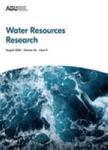版权所有:内蒙古大学图书馆 技术提供:维普资讯• 智图
内蒙古自治区呼和浩特市赛罕区大学西街235号 邮编: 010021

作者机构:Royal Netherlands Meteorol Inst KNMI R&D Observat & Data Technol De Bilt Netherlands Wageningen Univ & Res Hydrol & Quantitat Water Management Grp Wageningen Netherlands Ecole Polytech Fed Lausanne Lausanne Switzerland Univ Bern Inst Geog Bern Switzerland Univ Bern Oeschger Ctr Climate Change Res Bern Switzerland
出 版 物:《WATER RESOURCES RESEARCH》 (水资源研究)
年 卷 期:2018年第54卷第12期
页 面:10293-10312页
核心收录:
学科分类:0710[理学-生物学] 0830[工学-环境科学与工程(可授工学、理学、农学学位)] 08[工学] 081501[工学-水文学及水资源] 0815[工学-水利工程]
基 金:grant MISTRALS/HyMeX ANR-2011-BS56-027
主 题:urban rainfall personal weather station simulation microwave link small-scale opportunistic sensing
摘 要:Many applications in urban areas require high-resolution rainfall measurements. Typical operational weather radars can provide rainfall intensities at 1-km(2) grid cells every 5min. Opportunistic sensing with commercial microwave links yields path-averaged rainfall intensities (typically 0.1-10km) within urban areas. Additionally, large amounts of urban in situ rainfall measurements from amateur weather observers are obtainable in real-time. The accuracy of these three techniques is evaluated for an urban study area of 20x20km, taking into account their respective network layouts and sampling characteristics. We use two simulated rainfall events described in terms of drop size distributions on a 100-m grid and with a temporal resolution of 30s. Accurate radar rainfall estimation with the Z-R relationship relies heavily on an appropriate choice of parameters, and a dual-polarization strategy is more suitable for higher intensities. Under ideal measurement conditions, the weather station network is the most promising, with a Pearson correlation coefficient above 0.86 and a relative bias below 4% for 100-m rainfall estimates at 5-min resolution. Microwave link rainfall observations contain the largest error, shown by a consistently larger coefficient of variation. The accuracy of all techniques improves when considering rainfall at larger scales, especially by increasing time intervals, with the strongest improvements found for microwave links for which errors are largely caused by their temporal sampling. Sparser networks are examined, showing that the decline in measurement accuracy only becomes significant when the link and station network density are reduced to less than half their levels in Amsterdam.